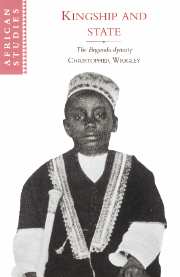Book contents
- Frontmatter
- Contents
- List of illustrations
- Preface
- Notes on language
- List of abbreviations
- 1 Preamble
- 2 The story and its making
- 3 Introduction to myth
- 4 Introduction to Buganda
- 5 The remoter past
- 6 Genesis
- 7 The cycle of the kings
- 8 Fragments of history
- 9 Foreign affairs
- 10 The making of the state
- 11 Reflections
- Notes
- Bibliography
- Index
- Other books in the series
10 - The making of the state
Published online by Cambridge University Press: 12 January 2010
- Frontmatter
- Contents
- List of illustrations
- Preface
- Notes on language
- List of abbreviations
- 1 Preamble
- 2 The story and its making
- 3 Introduction to myth
- 4 Introduction to Buganda
- 5 The remoter past
- 6 Genesis
- 7 The cycle of the kings
- 8 Fragments of history
- 9 Foreign affairs
- 10 The making of the state
- 11 Reflections
- Notes
- Bibliography
- Index
- Other books in the series
Summary
Memories of crisis
Commentators have long recognised the reign of Mawanda (K.22) as the main formative period in the history of the Ganda state. He found a still fairly small kingdom near the north-west corner of the Lake and left it a major power, which stretched from the Katonga to the Nile and far into the interior, having created a hierarchy of appointed officers to govern it. The orientation of the kingdom was also significantly altered. The earlier expansion in the time of Kateregga and Mutebi had been to the west, with the incorporation of Butambala, Gomba, Busujju and part of Ssingo; and it was clearly in this part of the kingdom that Mawanda's power-base lay. His first capital was at Katakala in southern Ssingo and he claimed to be a nephew of the Leopard clan, keepers of the shrine of Kintu at Magonga in Busujju. We saw, too (above pp. 117–18), how he attempted to enlist the great Ancestor as the patron of his rule. But from this western base Mawanda pushed Ganda power far to the east. According to the story, it was the pursuit of the tyrant Kagulu that first brought him and his sister Ndege into the coastlands east of Murchison Bay, where he developed contacts with local groups which were incorporated into Buganda as the Sprat and Jackal clans, and with others that recognised the Sheep and Bean emblems. Once on the throne, he organised this area together with its hinterland as the rich marcher province of Kyaggwe, and used it as a base for profitable raids on the people of south-west Busoga beyond the Nile.
- Type
- Chapter
- Information
- Kingship and StateThe Buganda Dynasty, pp. 207 - 229Publisher: Cambridge University PressPrint publication year: 1996

